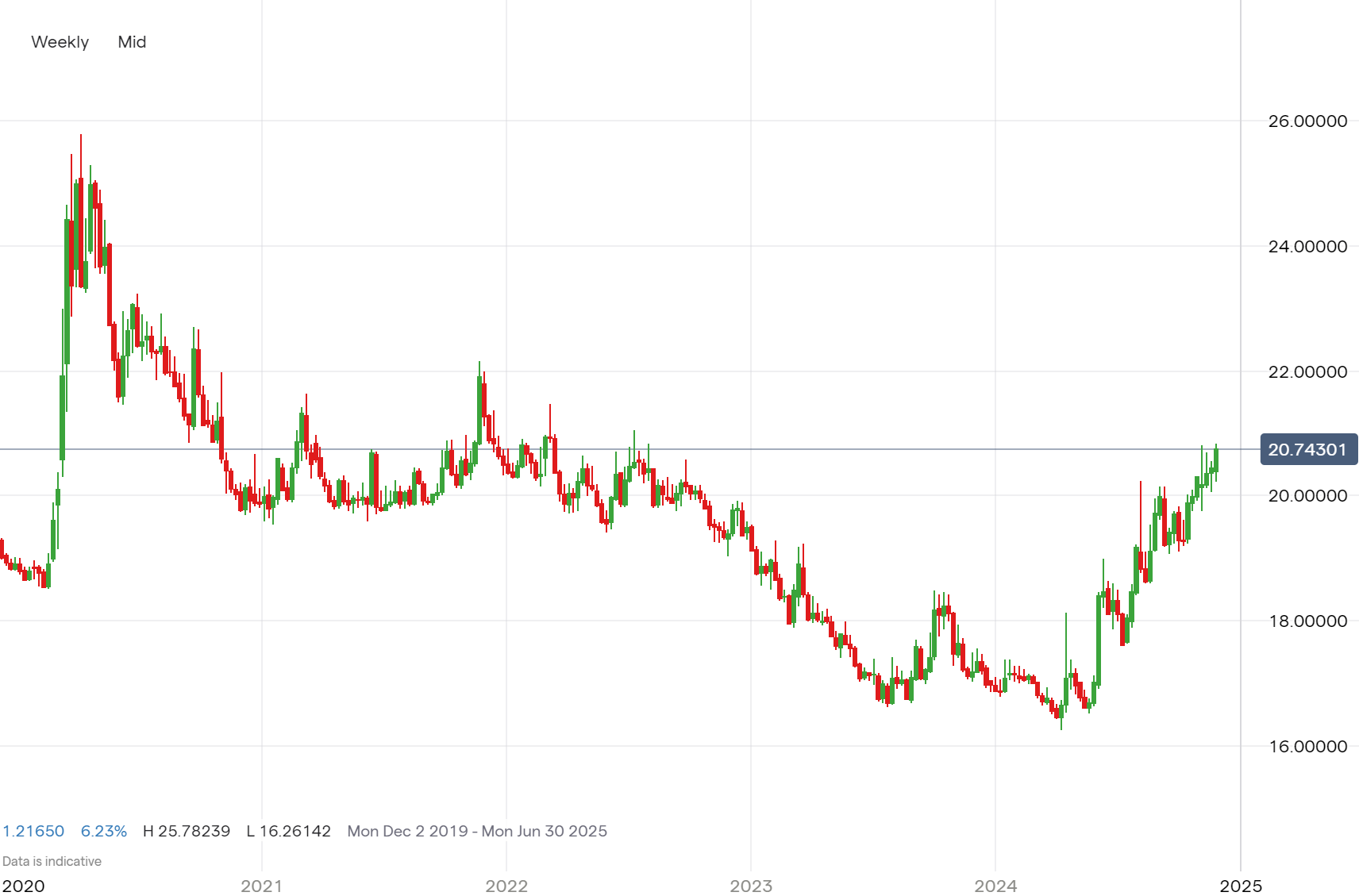USD/MXN price action: How might Trump’s tariffs affect the peso?
Tariff tensions push USD/MXN above 20.7, highlighting Mexico's economic challenges amid potential trade disruptions and domestic fiscal concerns, as the peso grapples with a strong US dollar backdrop.

Key points
- USD/MXN rises above 20.81266, a low not seen since March 2022
- Trump announces 25% tariffs on imports from Mexico and Canada
- Peso depreciates approximately 20% this year amid fiscal concerns
- Mexico's auto sector potentially impacted by new tariffs
- US accounts for over 83% of Mexican exports
USD/MXN hits new high above 20.7
The Mexican peso has fallen to 20.81266 per USD, marking its weakest since March 2022, following Donald Trump's renewed tariff threats. He announced plans for a 25% tariff on imports from Mexico and Canada, which could significantly impact Mexico, the US's largest trading partner, particularly affecting the auto sector. In response, Mexican President Claudia Sheinbaum suggested retaliatory tariffs. The peso has depreciated about 20% this year, pressured by Sheinbaum's election win in June, fears of increased government spending, and higher debt levels. The decline has intensified since Trump's election, with a strong US dollar exacerbating the peso's weakness.
USD/MXN price history

Mexico’s president warns Trump over tariff threats
If Mexican President Claudia Sheinbaum implements retaliatory tariffs in response to Trump's proposed tariffs, it could significantly impact the Mexican peso and the economic ties between Mexico and the United States. Given that the US accounts for over 83% of Mexico's exports, any disruption in this relationship could strain Mexico's trade balance, potentially leading to a trade deficit that would further pressure the peso. The major automotive companies, such as General Motors, Stellantis, and Ford Motors, which are integral to Mexico's export economy, could face production cuts and job losses, negatively affecting economic growth and investor confidence. This scenario could lead to increased volatility and uncertainty in the foreign exchange markets, prompting investors to seek safer assets and potentially causing further depreciation of the peso. Additionally, the perceived risk of a trade conflict might deter global investors, resulting in capital withdrawal from Mexican markets. In response, the Mexican government might need to adjust domestic policies, such as fiscal or monetary interventions, to stabilize the economy and the peso. In the long run, Mexico could seek to diversify its export markets to reduce dependency on the US, which would require strategic investments and time.
A softening US dollar and its impact
The dollar index dropped to 106.1 on Wednesday, reaching a one-week low as investors scrutinized recent economic data and President-elect Trump’s cabinet selections for insights into the Federal Reserve's future strategies. The data revealed a 2.8% annualized growth in the US economy for Q3, although core PCE inflation was adjusted downward. Fed meeting minutes showed policymakers' cautious stance due to an unclear economic outlook and ongoing inflation challenges. While a December rate cut remains possible, expectations for 2025 cuts have decreased to a total of 50bps. Fed officials also discussed reducing the reverse repo rate to the lower end of the target funds rate, given that facility usage has fallen to its lowest since April 2021.
What’s next for USD/MXN?
The peso’s depreciation is spurred by Trump’s tariff threats, announcing a 25% tariff on imports from Mexico, which could severely impact Mexico's economy, particularly the auto sector. The peso's decline is compounded by domestic factors like President Claudia Sheinbaum's election and fears of fiscal expansion and debt. If Mexico retaliates with its own tariffs, this could further disrupt the crucial trade relationship, potentially leading to a trade deficit and increased peso volatility. The uncertainty surrounding trade tensions might deter investors, prompting a capital exodus from Mexico. Meanwhile, the US dollar shows signs of strength despite a recent dip in the dollar index to 106.1, driven by an annualized 2.8% growth in the US economy and cautious Federal Reserve policies. As the peso struggles against a strong dollar, Mexico may need to consider domestic policy adjustments or seek to diversify its export partners to mitigate dependency on the US, all while navigating the immediate challenges posed by potential trade conflicts.
How to trade USD/MXN
- Open an account to get started, or practice on a demo account
- Choose your forex trading platform
- Open, monitor, and close positions on USD/MXN
Trading forex requires an account with a forex provider like tastyfx. Many traders also watch major forex pairs like EUR/USD and USD/JPY for potential opportunities based on economic events such as inflation releases or interest rate decisions. Economic events can produce more volatility for forex pairs, which can mean greater potential profits and losses as risks can increase at these times.
You can help develop your forex trading strategies using resources like tastyfx’s YouTube channel. Our curated playlists can help you stay up to date on current markets and understanding key terms. Once your strategy is developed, you can follow the above steps to opening an account and getting started trading forex.
Your profit or loss is calculated according to your full position size. Leverage will magnify both your profits and losses. It’s important to manage your risks carefully as losses can exceed your deposit. Ensure you understand the risks and benefits associated with trading leveraged products before you start trading with them. Trade using money you’re comfortable losing. Past performance is not indicative of future results.
